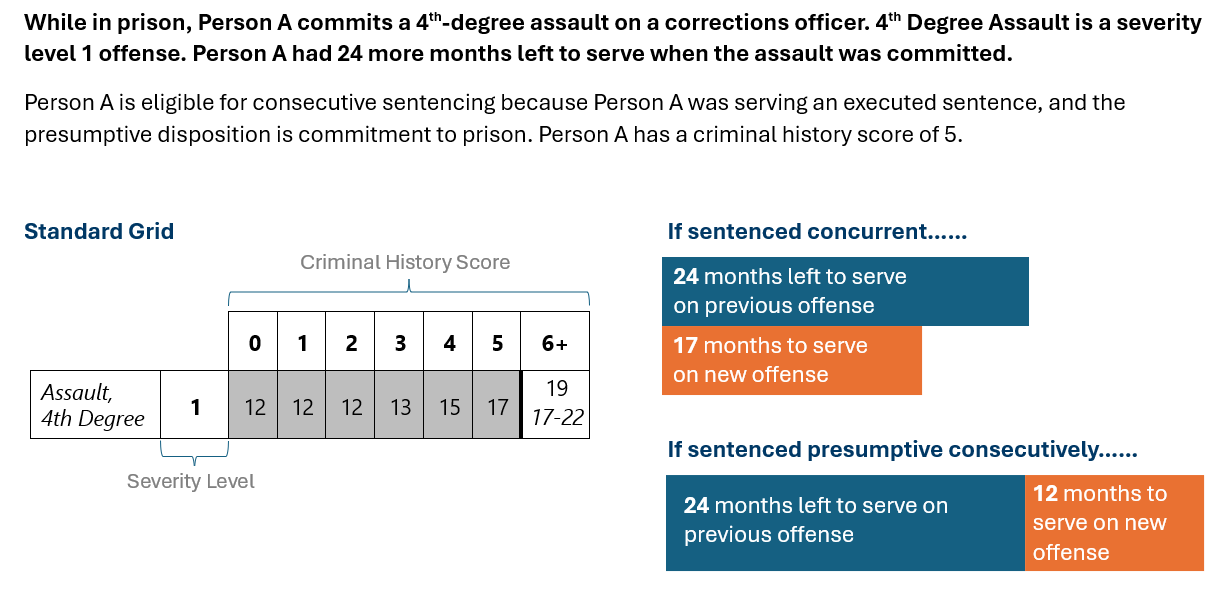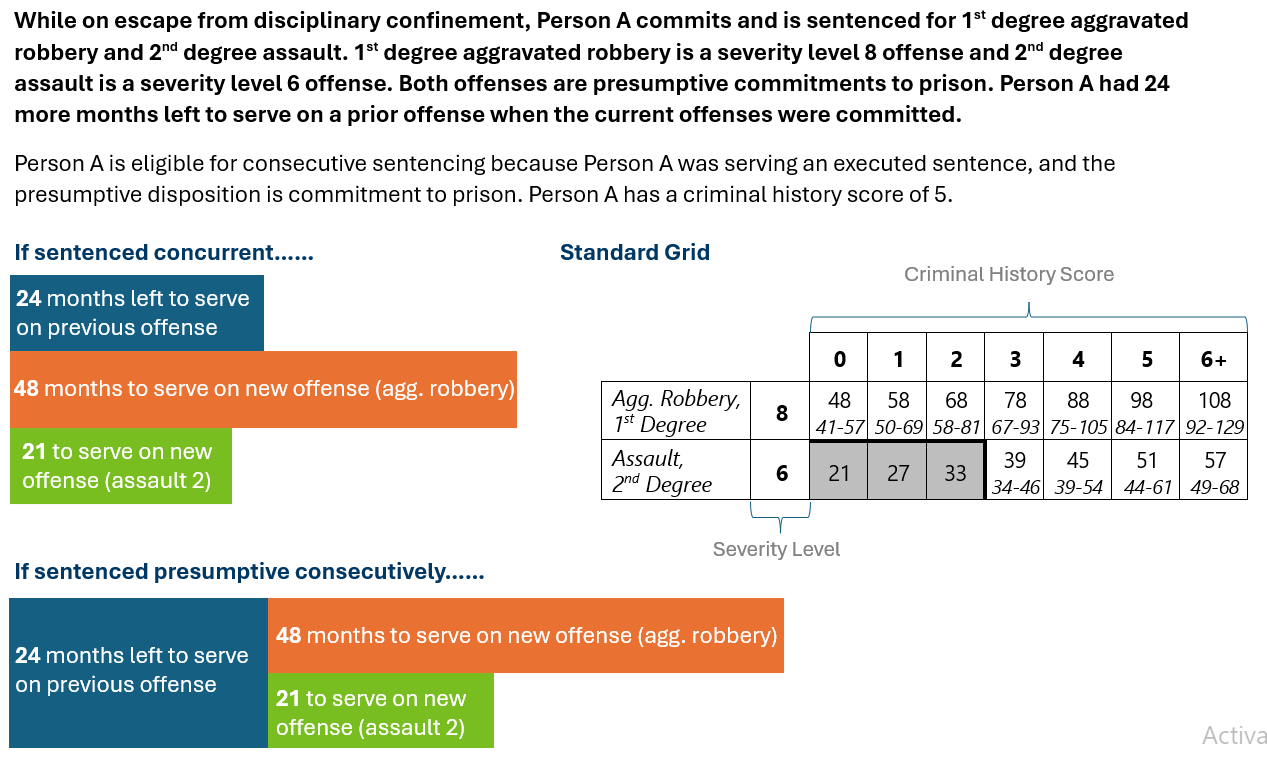Presumptive Consecutive Sentencing
Guidelines Section 2.F.2
A "presumptive consecutive sentence" means that, according to sentencing guidelines, a judge is expected to order multiple sentences to be served one after the other (consecutively) for a specific crime, unless there are strong mitigating factors justifying a concurrent sentence; essentially, it is the standard practice to sentence this way for certain offenses based on the criminal history and nature of the crime involved.
Criteria for Imposing a Presumptive Consecutive Sentence
Consecutive sentences are presumptive (required under the Guidelines) when.....
....at the time of the current offense, the defendant was.....
- serving an executed term of imprisonment, disciplinary confinement, or reimprisonment; OR
- on escape status from an executed term of imprisonment, disciplinary confinement, or reimprisonment; AND ...the presumptive disposition of the current offense(s) is commitment to prison.
More to Know
It is presumptive for escape from an executed term of imprisonment and for felony assault committed by an inmate serving an executed term of imprisonment to be sentenced consecutively to the offense for which the inmate was confined. The presumptive disposition for an escape from an executed sentence or for a felony assault committed by an inmate serving an executed term of imprisonment is always confinement.
If the criteria in paragraph 2.F.1.a have been met but the total time to serve in prison would be longer if a concurrent sentence were imposed, a concurrent sentence is presumptive. Otherwise, a concurrent sentence is a departure.
If there is evidence that the defendant has provided substantial and material assistance in the detection or prosecution of crime, the court may depart from the presumptive consecutive sentence and impose a concurrent sentence
Attempts & Conspiracies: If the offense is an attempt under Minn. Stat. § 609.17, or a conspiracy under Minn. Stat. § 609.175, and the court pronounces a presumptive consecutive sentence, the presumptive duration for each offense sentenced consecutively to another offense is determined by first locating the duration in the appropriate cell on the applicable Grid at a Criminal History Score of 1, then applying the rules for attempts and conspiracy set forth in section 2.G.2.
How to Find the Presumptive Duration
For each offense sentenced consecutively to another offense(s) under 2.F.1, the presumptive duration in the appropriate cell on the applicable Grid at a Criminal History Score of 1, or the mandatory minimum for the offense, whichever is longer.
Example
Consecutive Sentences for Multiple Offenses
When the court pronounces presumptive consecutive sentences for multiple offenses, each new offense will be sentenced at a Criminal History Score of 1. The new offenses will run concurrently to each other, but consecutive to the prior offense. Permissive consecutive sentencing under section 2.F.2 is not a departure if it would result in a longer sentence than the sentence resulting from this rule.
Example
Things to Know
It is presumptive for escape from an executed term of imprisonment and for felony assault committed by an inmate serving an executed term of imprisonment to be sentenced consecutively to the offense for which the inmate was confined. The presumptive disposition for an escape from an executed sentence or for a felony assault committed by an inmate serving an executed term of imprisonment is always confinement.
If the criteria in paragraph 2.F.1.a have been met but the total time to serve in prison would be longer if a concurrent sentence were imposed, a concurrent sentence is presumptive. Otherwise, a concurrent sentence is a departure.
If there is evidence that the defendant has provided substantial and material assistance in the detection or prosecution of crime, the court may depart from the presumptive consecutive sentence and impose a concurrent sentence.
Felony Driving While Impaired: Minn. Stat. § 169A.28 subd. 1 requires a consecutive sentence when the court sentences an offender for a felony DWI and:
1. the offender has a prior unexpired misdemeanor, gross misdemeanor, or felony DWI; AND (2) the disposition of the current offense will be probation; BUT NOT (3) when the disposition for the current offense will be commitment.
If the court pronounces a consecutive sentence, the presumptive duration is based on a Criminal History Score of 1. Any pronounced probationary jail time should be served consecutively to any remaining time to be served on the prior DWI offense.
Attempts & Conspiracies: If the offense is an attempt under Minn. Stat. § 609.17, or a conspiracy under Minn. Stat. § 609.175, and the court pronounces a presumptive consecutive sentence, the presumptive duration for each offense sentenced consecutively to another offense is determined by first locating the duration in the appropriate cell on the applicable Grid at a Criminal History Score of 1, then applying the rules for attempts and conspiracy set forth in section 2.G.2.

